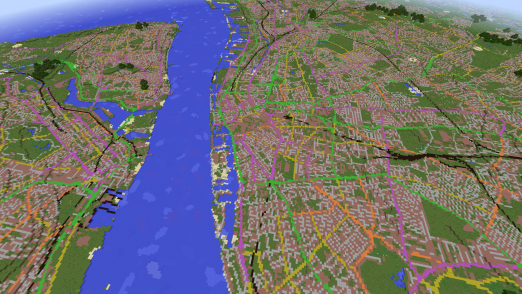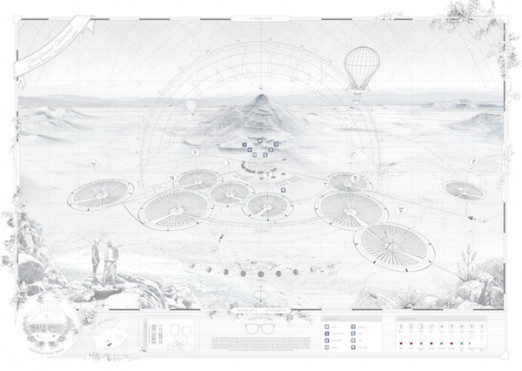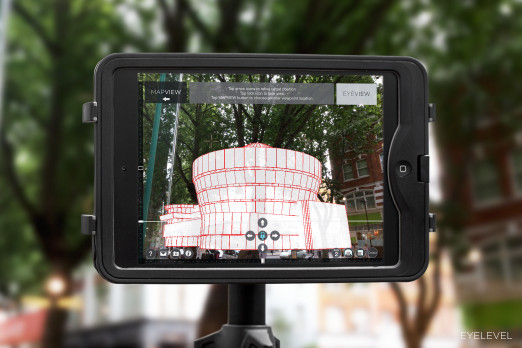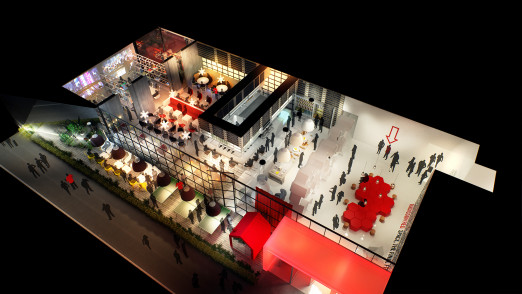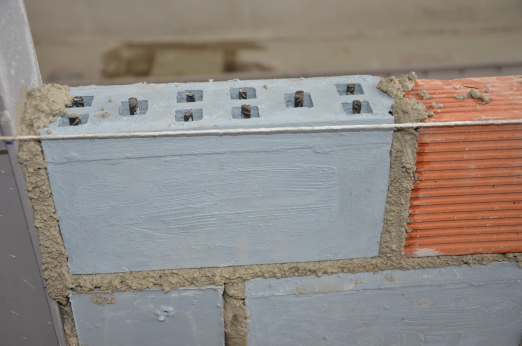Winners of the RIBA's Visualising the future of the city - what will your city look like in 2065? competition.
First: Cambedoo Solar Estate By John Cook University of Westminster, London, United Kingdom
In an age of dramatically rising population, diminishing fossil fuel resources and the alarming and all too visible consequences of climate change, the Camdeboo Solar Estate looks to provide an alternative energy strategy and agricultural resource for South Africa’s burgeoning cities and rising energy demands.
Located in a remote municipality in the semiarid environment of the Karoo, its array of CSP (Concentrated Solar Power) plants are hybridised with the long practiced technique of terraced farming to enable a bountiful and economically prosperous wine production industry. Masterplan arrangement has axial pathways and internal orientations calibrated to the positions of the celestial objects within our solar system at the time of opening, 2050.
By 2065, a new economy of solar tourism has been embedded in the region, where agriculture, energy production and celestial movements become entwined and experienced as a new form of urban / territorial restructuring.
Second: London the floating square mile by Assia Stefanova Newcastle University, United Kingdom
London is often referred to as “one of the biggest tax evasion islands”. Here it becomes the site for a tax haven, constructed in the airspace over the Square Mile, London’s financial center. The new island drains the resources of the city below, whilst giving back the abandoned land to ordinary citizens.
The project is a critique of the growing gap between the wealthiest 0.1% and the rest of the world’s population, and the role that technology plays in the monopolisation of power and resources. As the housing problem within big cities continues to grow, the towers on the island are rarely inhabited by their owners yet must be constantly maintained by a disproportionate number of staff.
The architectural language is a distorted version of Christopher Wren’s architecture and his unrealised, utopian proposal for the masterplan of London. Value is questioned as the buildings are a 3D printed camouflage, concealing a steel lattice structure.
Joint third: Resuscitating Dhaka by Bin Sayeed Bakhti and Manal Anis Bangladesh University of Engineering and Technology (BUET), Dhaka, Bangladesh
Being oblivious to the consequences of squandering away the country’s resources for urbanisation, Dhaka apparently is heading towards a point of saturation.
However, time and again Bengalis have been capable of coming around from the verge of cynicism and desperation only to survive. Therefore, it is only after this point has been reached that people, endowed with true awareness, will come together bringing about an influx of positive change.
Dhaka, 50 years from now, shall be in the epicentre of such regeneration and armed with her own uniqueness will pull through stronger than ever before. The city will, ultimately, witness a harmony between legalised slums and contemporary architecture; loops of flyovers, roads and restored water channels: globalisation and age-old cultural norms. The aftermath will be an exhilarating oriental triumph breathing new life into a nearly depleted city. Through such inevitable growth, Bengalis will, eventually, emerge with a truly developed South Asian tropical city.
Joint third: My Intelligent City By Ryohei Fukuhara, Yuki Abe, Kuniatsu Ishihara, Hiroki Oshima, Kohei Osako, Shonnsuke Seki, Kana Morioka, Zhang Yandong – Mie University, Mie, Japan
In 2011 a massive earthquake destroyed a number of cities in northern Japan, and caused radioactive disaster from the nuclear power plant. This started advanced discussions on energy issues.
In the past there was industrial pollution. Yokkaichi City in Mie Prefecture was one of the worst damaged cities from petro-chemical production.
Meanwhile, in Mie Prefecture Japanese Principal Shrine called ‘Ise Jingu’ is located. The Shrine succeeds the original shape from 1300 year before by rebuilding the same shape every two decades. The deed hands down the traditional building methodology and circulates the building material to other shrines, realising a Japanese tradition of “Sustainability”.
Mie has various nature features and ways to produce energy and to reduce its consumption.


